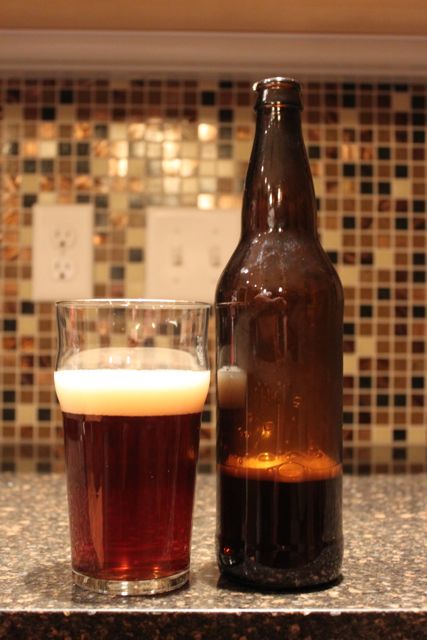The siren song of the sampler pack got me again. I am lazy and did not bottle my latest batch of homebrew—an Australian sparkling ale—until this weekend, so I have found myself lacking in the liquid refreshment department. A trip downtown to Benz Beverage Depot is always dangerous because the plethora of bottles and cans is overload for my brain. In a good way, of course.
On an endcap was an eight can sampler from the Tallgrass Brewing Company out of Manhattan, Kansas. At the time I was relatively unfamiliar with Tallgrass having only sampled a small glass of their Velvet Rooster at a beer tasting event over five years ago. The sampler pack contained two 16-ounce cans of Buffalo Sweat, Oasis ESB, 8-Bit, and IPA.
8-Bit already won a place in my heart with its label art:
I know that for a lot of people the term “8-bit” has little or no meaning. For someone who grew up with a Nintendo controller the term brings back fond memories of marathon sessions of Contra—yes, I remember the sequence of inputs to get 30 lives—and RC Pro-Am. I wonder if anyone will mythologize the later video game systems like individuals of my age bracket get misty when thinking about the original Nintendo Entertainment System?
The beer utilizes something called a hop rocket in its production. The hop rocket is an in-line hop infuser that really puts hop aromas at the fore of a beer. 8-Bit uses the Galaxy strain in the hop rocket which gives it a distinct aroma over beers that use more common Cascade, Centennial, or Willamette varieties. Normally, I am not a fan of dry hopped beers but 8-Bit was surprising. Anyone up for a game of Super Mario Brothers?
Oasis is a big beer:
At 7.2% ABV and 93 IBU, this about as big a beer as you get without starting to enter into the “extreme” category. By the way, who would have though a decade ago that a beer approaching 100 IBU would not be considered outrageous or extreme? Bueller? Bueller?
Even though Oasis is big, it manages to be a beer you can drink without feeling like you’re fighting each drink down in some exercise akin to self-flagellation. I attribute this to a heavy malt profile that compensates for the beer’s bigness in other areas. Too many “extreme” beers are thin on the malt and the attempt comes across as a carnival ride. You know, cheap thrill that leaves you wondering why you spent $5 to risk your life on something held together by a cotter pin placed by a Joe Dirt extra.
The originally named IPA gets a little lost:
Why? After the experience of the first two beers there is something that just seems so standard about IPA. Sure, it’s hopped pretty well (60 IBU), but after a can of Oasis that seems like a cool down following a marathon. It’s decently heavy at 6.3% ABV, but again after a can of Oasis you are coming down a little bit.
In the end, IPA is a well-crafted India Pale Ale. The problem is that this style has flooded the craft beer market and, increasingly, it is hard to tell one brewer’s well-crafted IPA from another well-crafted IPA. It’s an embarrassment of riches for beer drinkers, to be sure, but it has to be killing the marketing directors of these companies as they look for ways to stand out.
When something is referred to as sweat, buffalo or otherwise, the first drink is always a leap of faith:
At only 20 IBU, Buffalo Sweat is a very mild beer for a style that almost demands a little more bittering. The result is that the primary flavor you get is not of alcohol or hops, but of the roasted barley. It is almost like a smoked beer. As a matter of fact, I would have sworn this beer used smoked malt if I had not read the description that was devoid of any mention of smoked malt. Interesting.
On the same endcap was a four-pack of Halycon unfiltered wheat. With the weather getting warmer it seems like such a perfect time for wheat beers to make a comeback into the refrigerator. I picked up the cans as well:
Amazingly, at just 20 IBU this beer felt and tasted a little more “beer like” than Buffalo Sweat which also came in at 20 IBU. Unlike some other wheat beers, hops are brought forward via the aromas rather than bitterness. It works to make the beer seem bigger than it is without overpowering the delicate wheat base.
Thank you Tallgrass for spreading the good word about cans in you “Canifesto.” If there is a downside to cans for craft beer, I cannot find it. Small-scale canning equipment has been improved and brought down in price to such a level that it is within reach of almost any craft brewer packaging beer for retail distribution. I realize that 22 ounce bottles and six-packs of longnecks are the calling cards of the American craft beer vanguard, but cans are the future. Of all the craft beers that I have had in cans not a single one has had the distinctive “skunk” aroma or flavors associated with UV penetration. Plus, the cans are just a more environmentally sensible choice. Can all that you can!













